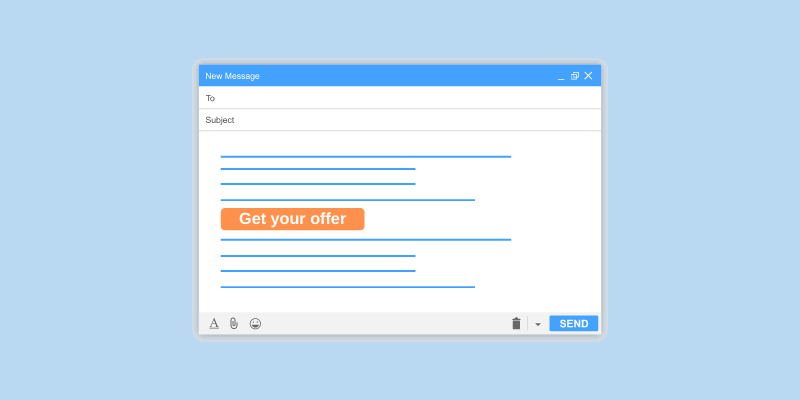The entire purpose of running an email campaign is to collect leads through a call-to-action [CTA]. If this purpose is not met, it does not matter if your emails make it to users’ inbox or not. The idea behind email marketing is that users click through the CTA and convert to the next stage of the buying journey.
Marketers aim to create compelling calls to action to seek the reader’s attention. An ideal CTA is the one that has equal open rates and click-through rates, which means that every user who reads your email has clicked through the CTA and took action. This is the objective, let us see how you can get there by following the ten best email marketing campaigns.
- Use action verbs
A call to action should answer two important questions – what and why? You need to address what the email recipient should do and why? The choice of words within the email has a high impact on the click-through rates [CTR]. The words in your call-to-action should persuade the reader to take action. You can include verb phrases to provoke subscribers to act.
For example: Instead of ‘Here is a free trial.’
You can say, ‘Sign up for a free trial.’
And include a word to encourage urgency ‘Sign up for a free trial today.’
Or personalize to the user by adding ‘I’ or ‘me’ like ‘Yes! I want a free trial.’
2. Do not Include CTA in the Image
Images and videos work better than a simple text message since a picture is better than a thousand words. However, a disadvantage of adding CTA in images is that most webmail and desktop email clients hide images by default, and they are never displayed until the reader chooses to open them. Why do users hide images? Because an image can send back potential information like your IP address, type of operating system, etc., and many of them consider it a security breach. So, without an image, there is no CTA, and if your readers cannot see a CTA, what will they click? The recommended course is always to use text-based CTAs and refrain from using graphic buttons.
3. Test your Calls-To-Action
Sometimes a minor change in CTA can significantly impact the click-through rate. Possibly, you will not know the difference unless you test multiple versions of your CTAs. CTAs should be tested with variables like placement, color, copy, etc., and based on the results, let the best one rule.
Ensure that you test one variable at a time because you will want to know which changes have brought better results and why.
4. Connect to the Corresponding Landing Page
Many marketing emails also come as click-bait; however, marketers resorting to such techniques are seldom successful. For example, if you want to increase your Facebook followers and run an email campaign with CTA stating ‘Signup for free coupons.’ A CTR on it can lead subscribers to ‘like’ your page and win coupons, but just because the messaging is vague – hiding the necessary action of liking the page, readers are likely to terminate the process as soon as they end up on your Facebook page. So, a CTA that says ‘Like us on Facebook’ is a better alternative.
5. Put CTA Above the Fold

Most marketers admit that customers usually do not read through to the end of emails. Instead, they just read the subject line or first one or two paragraphs before taking action. So, it is always a good idea to include at least one call to action above your email fold to grab attention immediately. By doing so, even if the reader decides not to scroll down your email, they can take action required quickly.
6. Size of the CTA
It is not just the button’s size but its relative size compared to its placement surroundings is what matters. It is simple. The call to action should not be too small, so you lose your readers, or too large because it is more prominent than required. Considering the increasing numbers of mobile users, you will need customized CTA buttons, so they are equally visible on both mobile and desktop. CTAs appearing on mobiles should be more obvious and clickable. You can test multiple CTAs as suggested before you decide on one.
Also Read: How to Create an Effective Email Newsletter for Your Business
7. Unclutter
Using multiple CTAs can have a negative impact and could result in no action being taken. The more choices you offer, the fewer steps you will get, or if readers’ chances of clicking on the CTA decreases when the number of CTAs increases. This happens primarily due to confusion on which one to connect, and they end up not clicking on any. In case you need to use multiple CTAs, they should not be more than three and ensure they are scattered through the length of the email leading to a single landing page.
8. Clear Message

Ensure that your CTA passes on a simple message to the reader. Do not complicate it with too many words. Limit the number of words to three or four. You do not want readers to invest more than two seconds to understand what it is about.
For example: ‘Avail the opportunity to win valuable offers’ might be a lengthy statement. Instead, ‘Get your offer’ is much better.
- Pick color and design
CTAs should stand out from other elements of the email. If you want a good CTR, ensure that they have an interesting design with contrasting colors that grab attention. A/B test the designs that might work, including circular, rectangular, or ovals buttons and their colors. Make sure that the CTA stands out on the email body or the page to ensure that itis fully visible and shouts “Click.”
- Personalize the copy
It is seen that the use of words, such as ‘me,’ ‘my,’ ‘I,’ or even the name of the reader, can improve click-through rates. Personalization is the key to mass marketing, and email is included. Why not? Wouldn’t you be interested to know that there is something out there just for you? Personalizing calls to action allows readers to see that you care for them and offer something unique. The fact is, they work.
For example: ‘Your cart is waiting.’
Instead, ‘John, your cart is waiting’ is more personalized.
Conclusion
Call to action is the most important part of your email, and you should make it as pleasing as possible to expect a click. Take time and think through the above-discussed pointers while designing a CTA, and before you decide on one, do not forget to test them.





